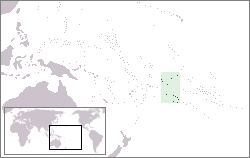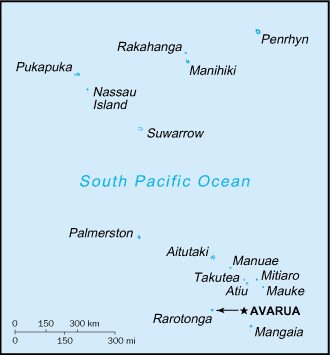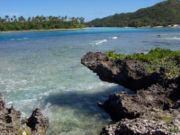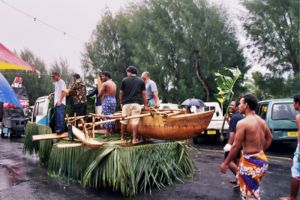Cook Islands
2008/9 Schools Wikipedia Selection. Related subjects: Oceania (Australasia)
| Cook Islands Kūki 'Āirani |
||||||
|---|---|---|---|---|---|---|
|
||||||
| Anthem: Te Atua Mou E God is Truth |
||||||
|
|
||||||
| Capital (and largest city) |
Avarua |
|||||
| Official languages | English Cook Islands Māori |
|||||
| Demonym | Cook Islander | |||||
| Government | Constitutional monarchy | |||||
| - | Head of State | Queen Elizabeth II | ||||
| - | Queen's Representative |
Sir Frederick Goodwin |
||||
| - | Prime Minister | Jim Marurai | ||||
| Associated state | ||||||
| - | Self-government in free association with New Zealand | 4 August 1965 | ||||
| Area | ||||||
| - | Total | 236 km² ( 209th) 91 sq mi |
||||
| Population | ||||||
| - | Mar 2006 estimate | 18,700 ( 218th (2005)) | ||||
| - | 2001 census | 18,027 | ||||
| - | Density | 76/km² ( 117th) 197/sq mi |
||||
| GDP ( PPP) | 2005 estimate | |||||
| - | Total | $183.2 million ( not ranked) | ||||
| - | Per capita | $9,100 ( not ranked) | ||||
| Currency | New Zealand dollar ( Cook Islands dollar also used) ( NZD) |
|||||
| Time zone | ( UTC-10) | |||||
| Internet TLD | .ck | |||||
| Calling code | +682 | |||||
The Cook Islands ( Cook Islands Māori: Kūki 'Āirani) are a self-governing parliamentary democracy in free association with New Zealand. The fifteen small islands in this South Pacific Ocean country have a total land area of 240 square kilometres (92.7 sq mi), but the Cook Islands Exclusive Economic Zone (EEZ) covers 1.8 million square kilometres (0.7 million sq mi) of ocean.
The main population centres are on the island of Rarotonga (c.10,000), where there is an international airport. There is also a much larger population of Cook Islanders in New Zealand, particularly the North Island; in the 2006 census, 58,008 self-identified as being of ethnic Cook Island Māori descent.
With over 90,000 visitors travelling to the islands in 2006, tourism is the country's number one industry, and the leading element of the economy, far ahead of offshore banking, pearls, marine and fruit exports.
Defence is the responsibility of New Zealand, in consultation with the Cook Islands and at its request. In recent times, the Cook Islands have adopted an increasingly independent foreign policy.
Politics
The politics of the Cook Islands takes place in a framework of a parliamentary representative democratic associated state, whereby the Queen of New Zealand, represented in the Cook Islands by the Queen's Representative, is Head of State and the Chief Minister is the head of government. There is a pluriform multi-party system and the islands are self-governing in free association with New Zealand and fully responsible for both internal and external affairs. New Zealand no longer has any responsibility for external affairs. As of 2005, it has diplomatic relations in its own name with eighteen other countries. Executive power is exercised by the government. Legislative power is vested in both the government and the Parliament of the Cook Islands.
The Cook Islands are not United Nations full members but participate in WHO and UNESCO.
The Judiciary is independent of the executive and the legislature.
Historical dates
1595 — Spaniard Álvaro de Mendaña de Neira is the first European to sight the islands.
1606 — Spaniard Pedro Fernández de Quirós made the first recorded European landing in the islands when he set foot on Rakahanga.
1773 — Captain James Cook explores the islands and names them the Hervey Islands. Fifty years later they are renamed in his honour by Russian admiral and explorer Krusenstern.
1821 — English and Tahitian missionaries arrive, become the first non-native settlers.
1858 — The Cook Islands become united as a state, the Kingdom of Rarotonga.
1888 — Cook Islands are proclaimed a British protectorate and a single federal parliament is established.
1901 — The Cook Islands are annexed to New Zealand.
1924 — The All Blacks Invincibles stop in Rarotonga on their way to the United Kingdom and play a friendly match against a scratch Rarotongan team.
1946 — Legislative Council is established. For the first time since 1912, the territory has direct representation.
1965 — The Cook Islands become a self-governing territory in free association with New Zealand. Albert Henry, leader of the Cook Islands Party, is elected as the territory's first prime minister.
1974 — Albert Henry is knighted by Queen Elizabeth II
1979 — Sir Albert Henry is found guilty of electoral fraud and stripped of his premiership and his knighthood. Tom Davis becomes Premier.
1981 — Constitution is amended. Parliament grows from 22 to 24 seats and the parliamentary term is extended from four to five years. Tom Davis is knighted.
1985 — Rarotonga Treaty is open for signing in the Cook Islands creating a nuclear free zone in the South Pacific.
1986 — In January 1986, following the rift between New Zealand and the USA in respect of the ANZUS security arrangements Prime Minister Tom Davis declared the Cook Islands a neutral country, because he considered that New Zealand (which has control over the islands' defence and foreign policy) was no longer in a position to defend the islands. The proclamation of neutrality meant that the Cook Islands would not enter into a military relationship with any foreign power, and, in particular, would prohibit visits by US warships. Visits by US naval vessels were allowed to resume by Henry's Government.
1991 — The Cook Islands signed a treaty of friendship and co-operation with France, covering economic development, trade and surveillance of the islands' EEZ. The establishment of closer relations with France was widely regarded as an expression of the Cook Islands' Government's dissatisfaction with existing arrangements with New Zealand which was no longer in a position to defend the Cook Islands.
1995 — The French Government resumed its Programme of nuclear-weapons testing at Mururoa Atoll in September 1995 upsetting the Cook Islands. Henry was fiercely critical of the decision and dispatched a vaka (traditional voyaging canoe) with a crew of Cook Islands' traditional warriors to protest near the test site. The tests were concluded in January 1996 and a moratorium was placed on future testing by the French government.
1997 — Full diplomatic relations established with China.
1997 — In November, Cyclone Martin in Manihiki kills at least six people; 80% of buildings are damaged and the black pearl industry suffered severe losses.
2000 — Full diplomatic relations concluded with France.
2002 — Prime Minister Terepai Maoate is ousted from government following second vote of no-confidence in his leadership.
2004 — Prime Minister Robert Woonton visits China; Chinese Premier Wen Jiabao grants $16 m in development aid.
2006 — Parliamentary elections held. The Democratic Party keeps majority of seats in parliament, but parliament is unable to meet due to petitions filed by the Cook Islands Party over alleged voting irregularities.
Geography
The Cook Islands are in the South Pacific Ocean, north-east of New Zealand, between French Polynesia and Fiji. There are fifteen major islands, spread over 2.2 million square kilometres of ocean, divided into two distinct groups: the Southern Cook Islands, and the Northern Cook Islands of coral atolls.
The islands were formed by volcanic activity; the northern group is older and consists of six atolls (sunken volcanoes topped by coral growth). The climate is moderate to tropical.
The fifteen islands are grouped as follows:
- Southern Group
- Aitutaki
- Atiu (Enua-Manu or Island of Birds)
- Mangaia
- Ma'uke (Akatokamanava)
- Rarotonga (with capital, Avarua)
- Palmerston Island
- Manuae
- Mitiaro
- Takutea
- Northern Group
- Manihiki
- Nassau
- Penrhyn Island also known as Tongareva
- Pukapuka
- Rakahanga
- Suwarrow also called Suvorov
History
The Cook Islands were first settled in the 6th century A.D. by Polynesian people who migrated from nearby Tahiti, to the southeast.
Spanish ships visited the islands in the late sixteenth century; the first written record of contact with the Islands came with the sighting of Pukapuka by Spanish sailor Álvaro de Mendaña in 1595 who called it San Bernardo (" Saint Bernard"). Another Spaniard, Pedro Fernández de Quirós, made the first recorded European landing in the islands when he set foot on Rakahanga in 1606, calling it Gente Hermosa ("Beautiful People").
British navigator Captain James Cook arrived in 1773 and 1779 and named the islands the Hervey Islands; the name "Cook Islands", in honour of Cook, appeared on a Russian naval chart published in the 1820s.
In 1813, John Williams, a missionary on the Endeavour (not the same ship as that of Cook), made the first official sighting of the island of Rarotonga.
The first recorded landing on Rarotonga by Europeans was in 1814 by the Cumberland; trouble broke out between the sailors and the Islanders and many were killed on both sides.
The islands saw no more Europeans until missionaries arrived from England in 1821. Christianity quickly took hold in the culture and many islanders continue to be Christian believers today.
The Cook Islands became a British protectorate at their own request in 1888, mainly to thwart French expansionism. They were transferred to New Zealand in 1901. They remained a New Zealand protectorate until 1965, at which point they became a self-governing territory in free association with New Zealand. In that year, Albert Henry of the Cook Islands Party was elected as the first Prime Minister. Sir Albert Henry led the country until he was accused of vote-rigging. He was succeeded in 1978 by Tom Davis of the Democratic Party.
Today, the Cook Islands are essentially independent ("self-governing in free association with New Zealand") but New Zealand is tasked with overseeing the country's defence.
On June 11, 1980, the United States signed a treaty with New Zealand specifying the maritime border between the Cook Islands and American Samoa and also relinquishing its claim to the islands of Penrhyn Island, Pukapuka (Danger), Manihiki, and Rakahanga.
Culture
| Date | Name |
|---|---|
| January 1 | New Year's Day |
| January 2 | Day after New Year's Day |
| The Friday before Easter Sunday | Good Friday |
| The day after Easter Sunday | Easter Monday |
| April 25 | ANZAC Day |
| The first Monday in June | Queen's Birthday |
| during July | Rarotonga Gospel Day |
| August 4 | Constitution Day |
| October 26 | Gospel Day |
| December 25 | Christmas |
| December 26 | Boxing Day |
Art
Carving - Woodcarving is a common art form in the Cook Islands. Sculpture in stone is much rarer although there are some excellent carvings in basalt by Mike Taveoni. The proximity of islands in the southern group helped produce a homogeneous style of carving but which had special developments in each island. Rarotonga is known for its fisherman's gods and staff-gods, Atiu for its wooden seats, Mitiaro, Mauke and Atiu for mace and slab gods and Mangaia for its ceremonial adzes. Most of the original wood carvings were either spirited away by early European collectors or were burned in large numbers by missionary zealots. Today, carving is no longer the major art form with the same spiritual and cultural emphasis given to it by the Maori in New Zealand. However, there are continual efforts to interest young people in their heritage and some good work is being turned out under the guidance of older carvers. Atiu, in particular, has a strong tradition of crafts both in carving and local fibre arts such as tapa. Mangaia is the source of many fine adzes carved in a distinctive, idiosyncratic style with the so-called double-k design. Mangaia also produces food pounders carved from the heavy calcite found in its extensive limestone caves.
Weaving - The outer islands produce traditional weaving of mats, basketware and hats. Particularly fine examples of rito hats are worn by women to church on Sundays. They are made from the uncurled fibre of the coconut palm and are of very high quality. The Polynesian equivalent of Panama hats, they are highly valued and are keenly sought by Polynesian visitors from Tahiti. Often, they are decorated with hatbands made of minuscule pupu shells which are painted and stitched on by hand. Although pupu are found on other islands the collection and use of them in decorative work has become a speciality of Mangaia.
Tivaevae - A major art form in the Cook Islands is tivaevae. This is, in essence, the art of making handmade patchwork quilts. Introduced by the wives of missionaries in the 19th century, the craft grew into a communal activity and is probably one of the main reasons for its popularity.
National Flower
The National Flower of the Cook Islands is the Tiare Māori or Tiale Māoli.
Sport
Rugby union is the most popular sport in the Cook Islands with association football (soccer) and rugby league also popular.





